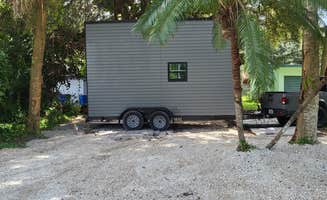Sanibel Island offers unique camping opportunities with several seasonal considerations. Located on Florida's Gulf Coast, the island sits at about 3 feet above sea level with average winter temperatures between 65-75°F and summer ranges from 75-90°F. Humidity peaks from June through October when afternoon rain showers are common, creating challenging conditions for tent campers without proper rain gear.
What to do
Kayak the Estero River: Rent equipment at Koreshan State Park Campground and paddle through jungle-like sections of the river. "The park offers hiking trails and close by access for launching kayaks. This park also has a walking tour of the Korshean Settlement which was interesting," notes a camper. Watch for alligators that inhabit the waterway.
Explore historic buildings: Koreshan State Park contains structures from the early 1900s with unusual architectural elements. "The buildings are pretty interesting, as is the beliefs these unusual folks held. History is, well…history…sometimes fact is stranger than fiction," remarks one visitor.
Bird watching opportunities: Wake up early at Periwinkle Park to observe the diverse bird population. "Have camped here twice this year. This is a bird watcher paradise. Lots of parrots as well as native birds. Love all the squawking when they wake up in morning!" One camper adds, "If you are around at feeding time, you can often see parrots riding around in a gold cart!"
What campers like
Beach accessibility without beachfront prices: Camping provides more economical accommodations compared to island hotels. "Nice campground with very flat campsites made setting up our small trailer a breeze. Very cost effective way to enjoy the island," reports one Periwinkle Park visitor. Another adds, "The prices are awesome for staying on Sanibel Island."
Swimming options beyond beaches: Camp Venice Retreat offers a heated pool for when gulf waters are too cold or rough. "Right on the river. Boat ramp awesome roomy sites. Bathrooms were clean. Nice pool," says one camper. The proximity to multiple water recreation options appeals to many glampers seeking variety.
Local wildlife encounters: Observe diverse animals from designated viewing areas. "Surrounded by water. Paradise," notes one camper at Fort Myers-Pine Island KOA. For a more secluded experience, try Horseshoe Primitive Campground where "we saw 4 campsites packed together and the entire field was open which had many other campsites... It was a great stay for 4 days with deer roaming the campground."
What you should know
Insect preparation is essential: No-see-ums and mosquitoes can be intense, especially at dusk. "Bugs were at their peak. No complaints, easy contact less check in and check out!" reports a camper at Fort Myers-Pine Island KOA. Another warns, "Good spot very clean with clean amenities. Wifi and cable access good too. Bring your bug spray. Lots of mosquitos."
Limited campfire options: Many Sanibel area glamping locations restrict fires due to regulations. At Cayo Costa State Park Campground, "you are pretty much on your own out there after the last ferry leaves for the day, enjoy a moonlit walk on the beach or an amazing sunset." Check specific campground rules before planning evening activities around a fire.
Transportation considerations: Island access often requires planning. "This is an out of the way park. The map may show that it's close to Sanibel and Ft Meyers but it is not really by car," explains a Fort Myers-Pine Island KOA visitor. Ferry schedules to Cayo Costa must be coordinated, as "remember, if you do take the ferry...know the times of arrival and departure...or you'll be staying another day."
Tips for camping with families
Wildlife education opportunities: Turn animal sightings into learning experiences. "The campsite is beautiful and well maintained. Lots of landscape and birds to see," shares a Periwinkle Park visitor. Children particularly enjoy the exotic bird sanctuary where they can observe various species up close.
Beach equipment logistics: Plan for transporting beach gear from campsite to shoreline. At San Carlos RV Resort & Marina, "we had a paved site on the river. We took the paddle boards over to the restaurant on the opposite side, short walk over the bridge to town and the beach." Many campgrounds offer wagon rentals or provide shuttle services.
Entertainment backup options: Have indoor alternatives ready for rainy afternoons. "Nice pool, laundry and bathrooms. Very quiet. Snook Haven restaurant next door is flat out awesome with twice daily entertainment at noon and 5pm most days," notes a Camp Venice Retreat visitor, providing options beyond outdoor activities.
Tips from RVers
Site selection strategy: Request specific sites based on your needs. At Camp Venice Retreat, "The sites along the river are super nice and should be on everyone's list to try to snag." Another RVer warns about Horseshoe Primitive Campground: "I'd suggest avoiding site 37 until it's renovated. Big tree in the middle, and soft sugar sand is hard to level."
Access challenges: Some roads leading to glamping sites near Sanibel have physical limitations. "The road going in has some potholes and lots of low hanging tree branches. Drive slow and stay in the middle if you can," advises a Camp Venice Retreat visitor. Measuring your RV height before booking prevents unexpected issues.
Seasonal booking timeline: Reserve 4-6 months ahead for winter stays. "Cayo Costa can book out as much as 6 months in advance. Plan your trip accordingly," warns an experienced camper. Summer offers more availability but requires preparation for heat and insects.



